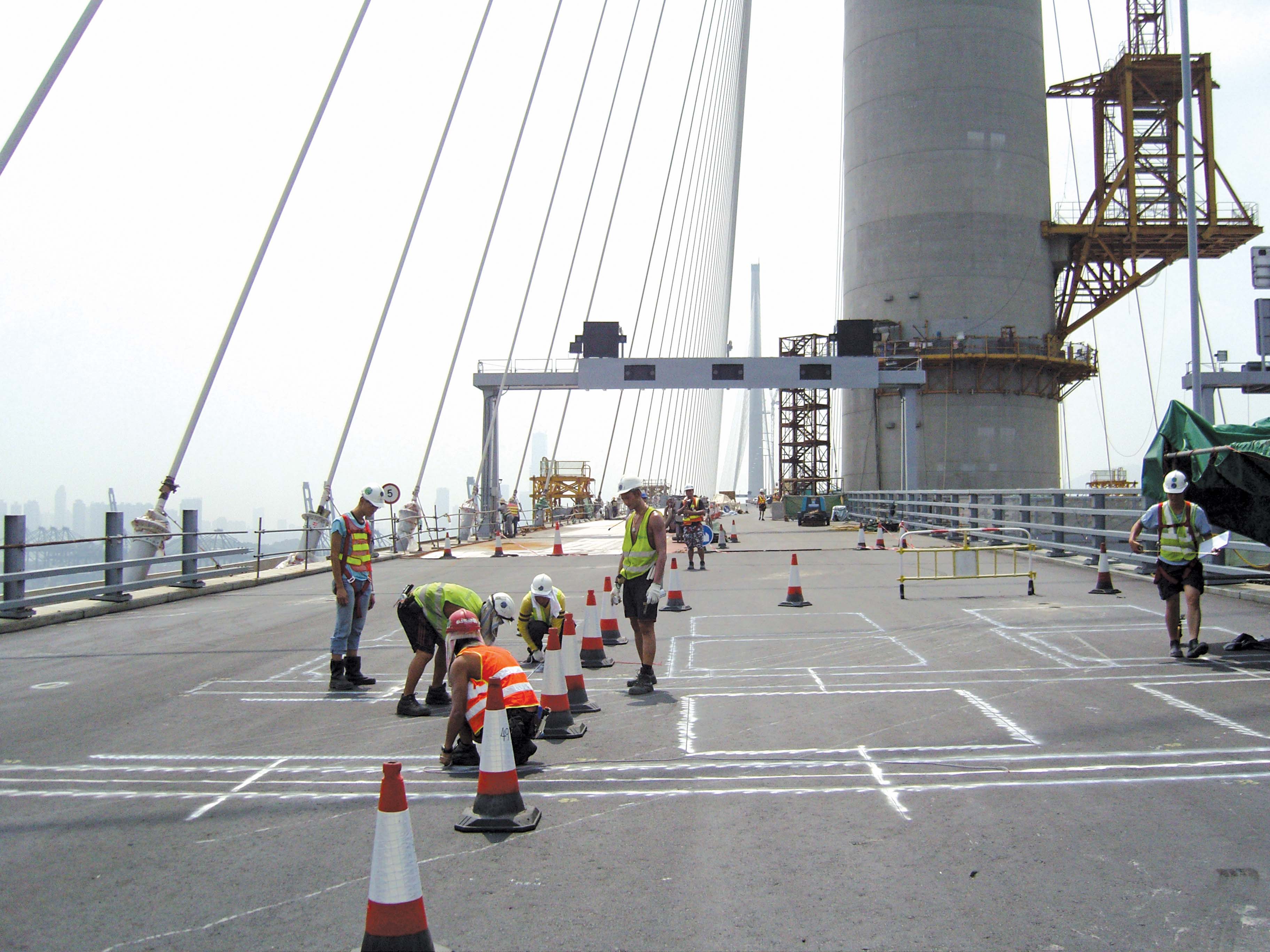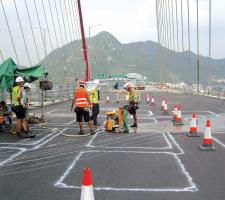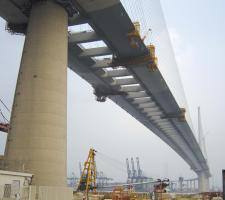
Stonecutter's Bridge has WIM installed on all lanes in both directions both before and after the deck.
Colin Sowman talks to Terry Bergan of International Road Dynamics about the latest uses of weigh-in-motion systems.
Raising allowable truck weight limits improve transport efficiency but leaves an ever-increasing number of bridges vulnerable to being overloaded and damaged by vehicles heavier, and in some cases far heavier, than they were designed to carry. The simplistic solution is to impose weight restrictions and erect appropriate signs - but this could have severe knock-on effect on trucking operations and may create new problems without providing the protection needed.
Terry Bergan, president and CEO of weigh-in-motion (WIM) specialist69 International Road Dynamics (IRD), points out that the stress on the bridge structure is a function of the total weight on the bridge at any given moment. “That could be a single heavy truck but more likely to be made up of a combination of loaded trucks, cars buses, vans and pick-ups on the bridge at the same time. So simply imposing a weight limit may not prevent every potentially damaging combinations of traffic on a bridge.”
He says road authorities are increasingly using a combination of ITS solutions including WIM equipment in multi-facetted protection and monitoring of infrastructure. This not only allows the authority to measure and enforce weight restrictions but to also calculate and monitor the total load on a bridge at any one time. Such a system can be used to allow the heavier to use the bridge while avoiding accelerated maintenance costs. To accommodate these new demands IRD has introduced i-BRDG; a bridge monitoring and safety system which can be configured in a variety of ways to meet particular requirements.
An agency’s first requirement is usually to stop truck drivers from blatantly ignoring weight limit by using a WIM system and automatic number plate recognition (ANPR). Adding variable message signs (VMS) to display the license plate number of any overweight vehicle may convince the driver not to proceed towards the bridge but if they do, the technology can alert the authorities and provide enforcement evidence.
However, Bergan still has to convince some authorities that the name of the game is not collecting fines (see box) and that penalising drivers of overweight vehicles for crossing the bridge is last and worst outcome. “The money saved by preventing a heavy vehicle from crossing a weak bridge far outweighs any fines the authority will collect. Once that truck has crossed the bridge, the damage will have been done - it’s far better to deter overweight trucks from crossing the bridge in the first place.”
He advocates ample signage to convey the message as early as possible, giving the heavy vehicle driver ample time and opportunity to select another route. “The further they have to retrace their steps, the more attractive it is to just carry on,” he says.
Beyond weight enforcement, the needs of each bridge and structure diversify and for instance with very weak bridges it can be beneficial to install WIM at both sides of the bridge and in both lanes. This not only allows maximum weight enforcement, it can also be configured to weigh all the vehicles going on to and off of the bridge to calculate the total load being carried at any one time. A system of VMS and traffic lights will enable the bridge authority to prevent two heavy trucks crossing the bridge at the same time. And depending on the length of the access roads, it may be possible to advise the truck driver to proceed at a particular speed to ensure other heavy vehicles have cleared the bridge before it arrives.
Of late, WIM data on vehicles using a bridge is being used to optimise the maintenance schedule and is particularly useful for weak bridges in remote locations which may otherwise require frequent visits from a structural engineer. To cater for these requirements the iBRDG can be configured to count the number of trucks crossing the bridge or monitor the combined gross weight of traffic that has crossed the bridge since the last inspection.
Some of the first bridge monitoring systems are installed in Hong Kong on the Shenzhen Western Corridor and the new Stonecutter’s Bridges. Shenzhen Western Corridor has WIM systems installed in all lanes prior to entering the bridge on both sides whereas with the Stonecutter’s Bridge the WIM is installed on both the entrance and exit lanes in both directions on both sides.
In the case of the Stonecutter’s Bridge this requires 48 WIM weighpads and equal number of loop sensors installed across four sites on the bridge, each of which is around 80 meters above the ground. All the data is fed into IRD’s iSINC electronics from the WIM scales and other sensors installed before, in and on the bridge deck and is used in estimating the operational life of the bridge. The vehicle weight/load information along with vibration and deflection readouts provides bridge inspectors and experts the data needed to determine the load and response of the bridge.
Both the Shenzhen Western Corridor and Stonecutter’s Bridge have incorporated WIM with a number of other bridge sensors to monitor the condition and performance of the structures and applied loads. This is then used in planning inspection and maintenance, validating design assumptions and updating and revising design manuals and standards.
Where bridges are situated in earthquake zones or exposed to strong winds the authorities are usually more concerned with monitoring ground or deck movements than they are in controlling the maximum load on the structure. However, Bergen says if WIM is installed for enforcement purposes, the authorities will also have an indication of the weight of the vehicles on the bridge if and when a tremor or strong gusts occur. This will enable the structural engineers to better assess the potential impact on the bridge(s) and to prioritise their response efforts.
Where authorities have installed WIM, it is increasingly being combined with over-height detection and automatic width/length measuring technology, bringing all infrastructure protection measures into a single facility.
According to Bergan this is the likely way forward: “WIM is becoming part of an enterprise system, measuring weights and dimensions. This can be coupled with a form of ID such as a licence plate reader or a transponder and cross referenced to checks on safety inspection records, driving hours and other items that are in the background. So what was once a simple weigh check could become a ‘safety station’ looking at all these factors.”
This is particularly the case with transit countries or individual US states that trucks drive through without delivering or picking up goods or even refuelling. As a result the host state pays for building and repairing the infrastructure while getting zero income to compensate for the wear and damage these ‘foreign’ trucks cause to roads and bridges. “The safety station concept can be used to check these vehicles are fully compliant with their domestic regulations and many authorities are considering using this type of technology to levy a weight/distance tax on foreign or out-of-state trucks,” Bergan says.
While weight/distance taxes are already a reality in areas like New Mexico and Oregon, Bergan says national governments are now considering similar schemes which are likely to be more advanced and include enforcement checks as well as charges. He predicts a system where heavy vehicles entering a state or country are run through a ‘safety station’ for a weight, dimensions and compliance check and, if satisfactory, are given a transponder before proceeding. When the vehicles exit the country or state, the driver drops off the transponder and pays the weight/distance tax.
According to Bergan, several countries are considering this type of technology which would enable an authority to police safety compliance of transiting trucks and recouping the cost of road wear they cause with the minimum of roadside infrastructure. What’s not to like?
Having been in the vehicle weighing industry for over 30 years, Bergan still finds the attitude of some authorities challenging: “In some areas of the world the authorities look on fines as a way of making money without understanding the much higher cost of repairing the damage overweight trucks are doing to their roads and infrastructure. If they do install WIM then the overweight trucks disappear and the authority says ‘there are no overweight trucks and we are not making money, so we don’t need a weigh station anymore’.
“If enforcement stops the overweight trucks will return even faster than they disappeared.”
Raising allowable truck weight limits improve transport efficiency but leaves an ever-increasing number of bridges vulnerable to being overloaded and damaged by vehicles heavier, and in some cases far heavier, than they were designed to carry. The simplistic solution is to impose weight restrictions and erect appropriate signs - but this could have severe knock-on effect on trucking operations and may create new problems without providing the protection needed.
Terry Bergan, president and CEO of weigh-in-motion (WIM) specialist
He says road authorities are increasingly using a combination of ITS solutions including WIM equipment in multi-facetted protection and monitoring of infrastructure. This not only allows the authority to measure and enforce weight restrictions but to also calculate and monitor the total load on a bridge at any one time. Such a system can be used to allow the heavier to use the bridge while avoiding accelerated maintenance costs. To accommodate these new demands IRD has introduced i-BRDG; a bridge monitoring and safety system which can be configured in a variety of ways to meet particular requirements.
An agency’s first requirement is usually to stop truck drivers from blatantly ignoring weight limit by using a WIM system and automatic number plate recognition (ANPR). Adding variable message signs (VMS) to display the license plate number of any overweight vehicle may convince the driver not to proceed towards the bridge but if they do, the technology can alert the authorities and provide enforcement evidence.
However, Bergan still has to convince some authorities that the name of the game is not collecting fines (see box) and that penalising drivers of overweight vehicles for crossing the bridge is last and worst outcome. “The money saved by preventing a heavy vehicle from crossing a weak bridge far outweighs any fines the authority will collect. Once that truck has crossed the bridge, the damage will have been done - it’s far better to deter overweight trucks from crossing the bridge in the first place.”
He advocates ample signage to convey the message as early as possible, giving the heavy vehicle driver ample time and opportunity to select another route. “The further they have to retrace their steps, the more attractive it is to just carry on,” he says.
Beyond weight enforcement, the needs of each bridge and structure diversify and for instance with very weak bridges it can be beneficial to install WIM at both sides of the bridge and in both lanes. This not only allows maximum weight enforcement, it can also be configured to weigh all the vehicles going on to and off of the bridge to calculate the total load being carried at any one time. A system of VMS and traffic lights will enable the bridge authority to prevent two heavy trucks crossing the bridge at the same time. And depending on the length of the access roads, it may be possible to advise the truck driver to proceed at a particular speed to ensure other heavy vehicles have cleared the bridge before it arrives.
Of late, WIM data on vehicles using a bridge is being used to optimise the maintenance schedule and is particularly useful for weak bridges in remote locations which may otherwise require frequent visits from a structural engineer. To cater for these requirements the iBRDG can be configured to count the number of trucks crossing the bridge or monitor the combined gross weight of traffic that has crossed the bridge since the last inspection.
Some of the first bridge monitoring systems are installed in Hong Kong on the Shenzhen Western Corridor and the new Stonecutter’s Bridges. Shenzhen Western Corridor has WIM systems installed in all lanes prior to entering the bridge on both sides whereas with the Stonecutter’s Bridge the WIM is installed on both the entrance and exit lanes in both directions on both sides.
In the case of the Stonecutter’s Bridge this requires 48 WIM weighpads and equal number of loop sensors installed across four sites on the bridge, each of which is around 80 meters above the ground. All the data is fed into IRD’s iSINC electronics from the WIM scales and other sensors installed before, in and on the bridge deck and is used in estimating the operational life of the bridge. The vehicle weight/load information along with vibration and deflection readouts provides bridge inspectors and experts the data needed to determine the load and response of the bridge.
Both the Shenzhen Western Corridor and Stonecutter’s Bridge have incorporated WIM with a number of other bridge sensors to monitor the condition and performance of the structures and applied loads. This is then used in planning inspection and maintenance, validating design assumptions and updating and revising design manuals and standards.
Where bridges are situated in earthquake zones or exposed to strong winds the authorities are usually more concerned with monitoring ground or deck movements than they are in controlling the maximum load on the structure. However, Bergen says if WIM is installed for enforcement purposes, the authorities will also have an indication of the weight of the vehicles on the bridge if and when a tremor or strong gusts occur. This will enable the structural engineers to better assess the potential impact on the bridge(s) and to prioritise their response efforts.
Where authorities have installed WIM, it is increasingly being combined with over-height detection and automatic width/length measuring technology, bringing all infrastructure protection measures into a single facility.
According to Bergan this is the likely way forward: “WIM is becoming part of an enterprise system, measuring weights and dimensions. This can be coupled with a form of ID such as a licence plate reader or a transponder and cross referenced to checks on safety inspection records, driving hours and other items that are in the background. So what was once a simple weigh check could become a ‘safety station’ looking at all these factors.”
This is particularly the case with transit countries or individual US states that trucks drive through without delivering or picking up goods or even refuelling. As a result the host state pays for building and repairing the infrastructure while getting zero income to compensate for the wear and damage these ‘foreign’ trucks cause to roads and bridges. “The safety station concept can be used to check these vehicles are fully compliant with their domestic regulations and many authorities are considering using this type of technology to levy a weight/distance tax on foreign or out-of-state trucks,” Bergan says.
While weight/distance taxes are already a reality in areas like New Mexico and Oregon, Bergan says national governments are now considering similar schemes which are likely to be more advanced and include enforcement checks as well as charges. He predicts a system where heavy vehicles entering a state or country are run through a ‘safety station’ for a weight, dimensions and compliance check and, if satisfactory, are given a transponder before proceeding. When the vehicles exit the country or state, the driver drops off the transponder and pays the weight/distance tax.
According to Bergan, several countries are considering this type of technology which would enable an authority to police safety compliance of transiting trucks and recouping the cost of road wear they cause with the minimum of roadside infrastructure. What’s not to like?
Having been in the vehicle weighing industry for over 30 years, Bergan still finds the attitude of some authorities challenging: “In some areas of the world the authorities look on fines as a way of making money without understanding the much higher cost of repairing the damage overweight trucks are doing to their roads and infrastructure. If they do install WIM then the overweight trucks disappear and the authority says ‘there are no overweight trucks and we are not making money, so we don’t need a weigh station anymore’.
“If enforcement stops the overweight trucks will return even faster than they disappeared.”














